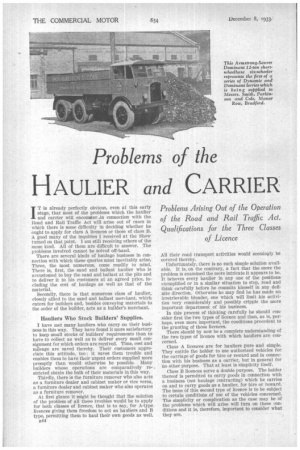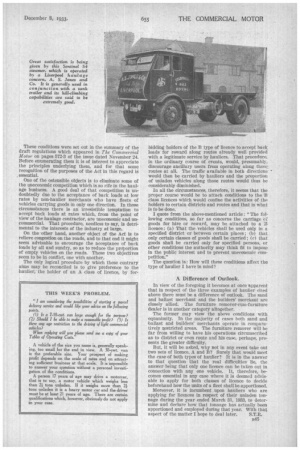Problems of the
Page 58

Page 59

If you've noticed an error in this article please click here to report it so we can fix it.
HAULIER and CARRIER
Problems Arising Out of the Operation of the Road and Rail Traffic Act. Qualifications for the Three Classes of Licence
IT is already perfectly obvious, even at this early stage, that most of the problems which the haulier and carrier will encounter .in connection with the Road and Rail Traffic Act will arise out of cases in which there is some difficulty in deciding whether he ought to apply for class A licences or those of class B. A good many of the inquiries I received at the Show turned on that point. I am still receiving others of the same kind. All of them are difficult to answer. The problems involved cannot be solved off-hand.
There are several kinds of haulage business in connection with which these queries must inevitably arise. Three, the most numerous, come readily to mind. There is, first, the sand and ballast haulier who is accustomed to buy the sand and ballast at the pits and to deliver it to his customers at an agreed price, including the cost of haulage as well as that of the material.
Secondly, there is that numerous class of haulier, closely allied to the sand and ballast merchant, which caters for builders and, besides conveying materials to the order of the builder, acts as a builder's merchant.
Hauliers Who Stock Builders' Supplies.
I have met many hauliers who carry on their business in this way. They have found it more satisfactory to keep small stocks of builders' requirements than to have to collect as well as to deliver every small consignment for which orders are received. Time, cost and mileage are saved thereby. Their customers appreciate this attitude, too : it saves them trouble and enables them to have their urgent orders supplied more promptly than would otherwise be possible. Many builders whose operations are comparatively restricted obtain the bulk of their materials in this way.
Thirdly, there is the furniture remover who also acts as a furniture dealer and cabinet maker or vice versa, a furniture dealer and cabinet maker who also operates as a furniture remover.
At first glance it might be thought that the solution of the problem of all these troubles would be to apply for both classes of licence, that is to say, for A-type licences giving them freedom to act as hauliers and B type, permitting them to haul their own goods as well.
344 All their road transport activities would seemingly be covered thereby.
Unfortunately, there is no such simple solution available. It is, on the contrary, a fact that the more the problem is examined the more intricate it appears to be. It behoves every haulier in any one of the positions exemplified or in a similar situation to stop, read and think carefully before he commits himself in any definite direction. Otherwise he may find he has made an irretrievable blunder, one which will limit his activities very considerably and possibly cripple the more important department of his business.
In this process of thinking carefully he should consider first the two types of licence and then, as is, perhaps, even more important, the conditions precedent to the granting of those licences.
There should by now be a complete understanding of the two types of licence with which hauliers are concerned.
Class A licences are for hauliers pure and simple. They entitle the holder to use authorized vehicles for the carriage of goods for hire or reward and in connection with his business as a carrier, but in general for no other purpose. That at least is simplicity itself.
Class B licences serve a double purpose. The holder thereof is permitted to carry goods in connec,tion with a business (not haulage contracting) which he carries on and to carry goods as a haulier, for hire or reward. The issue of this second type of licence is to be subject to certain conditions of use of the vehicles concerned. The simplicity or complication as the case may be of the problems which will arise will turn on these conditions and it is, therefore, important to consider what they are.
These conditions were set out in the summary of the draft regulations which appeared in The Commercial Motor on pages 572-3 of the issue dated November 24. Before enumerating them it is of interest to appreciate the principles underlying them, and for that some recognition of the purposes of the Act in this regard is essential.
One of the ostensible objects is to eliminate some of the uneconomic competition which is so rife in the haulage business. A good deal of that competition is undoubtedly due to the acceptance of back loads at low rates by non-haulier merchants who have fleets of vehicles carrying goods in only one direction. In those circumstances there is an irresistible temptation to accept back loads at rates which, from the point of view of the haulage contractor, are uneconomic and uncommercial. That procedure, needless to say, is detrimental to the interests of the industry at large.
On the other hand, another object of the Act is to relieve congestion on the roads, and to that end it might seem advisable to encourage the acceptance of back loads by all and sundry, so as to reduce the proportion of empty vehicles on the roads. These two objeCtives seem to be in conflict, one with another.
The only logical procedure by which these contrary aims may be reconciled is to give preference to the haulier, the holder of an A class of licence, by for
bidding holders of the B type of licence to accept back loads for reward along routes already well provided with a legitimate service by hauliers. That procedure, in the ordinary course of events, would, presumably, discourage ancillary users from operating along those routes at all. The traffic available in both directions would then be carried by hauliers and the proportion of unladen vehicles along those routes would thus be considerably diminished.
In all the circumstances, therefore, it seems that the proper course would be to attach conditions to the B class licences which would confine the activities of the holders to certain districts and routes and that is what Is to be done.
I quote from the above-mentioned article: "The following conditions, so far as concerns the carriage ce goods for hire or reward, may be attached to a B licence: (a) That the vehicles shall be used only in a specified district or between certain places ; (b) that only certain classes of goods shall be carried ; (c) that goods shall be carried only for specified persons, or other conditions the authority may think fit to impose In the public interest and to prevent uneconomic competition."
The question is: How will these conditions affect the type of haulier I have in mind?
A Difference of Outlook.
In view of the foregoing it becomes at once apparent that in respect of the three examples of haulier cited above there must be a difference of outlook. The sand and ballast merchant and the builders' merchant are closely allied. The furniture remover-cum-furniture dealer is in another category altogether.
The former may view the above conditions with equanimity. In the majority of cases both sand and ballast and builders' merchants operate in comparatively restricted areas. The furniture remover will be far from willing to have his operations circumscribed as to district or even route and his case, perhaps, presents the greater difficulty.
But, it will be asked, why not in any event take out two sets of licence, A and B? Surely that would meet the case of both types of haulier? It is in the answer to that question that the real difficulties lie, the answer being that only one licence can be taken out in connection with any one vehicle. It, therefore, becomes essential in any case where it is deemed advisable to apply for both classes of licence to decide beforehand how the units of a fleet shall be apportioned.
Moreover, it is incumbent upon hauliers who are applying for licences in respect of their unladen tonnage during the year ended March 31, 1933, to determine and declare how that tonnage has actually been apportioned and employed during that year. With that aspect of the matter I hope to deal later. S.T.R.




























































































